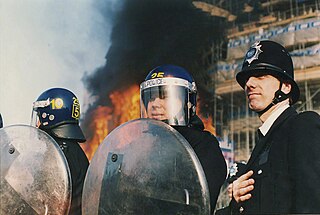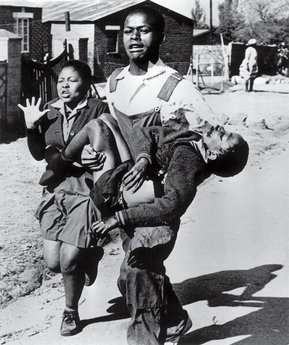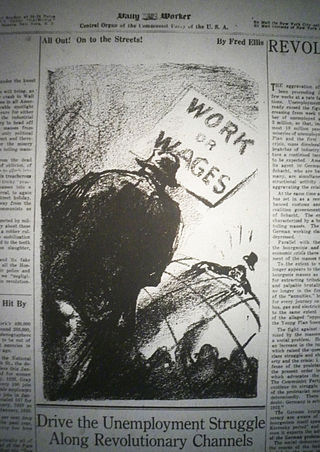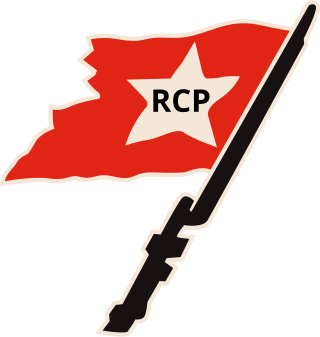Related Research Articles
The Greensboro massacre was a deadly confrontation which occurred on November 3, 1979, in Greensboro, North Carolina, US, when members of the Ku Klux Klan and the American Nazi Party (ANP) shot and killed five participants in a "Death to the Klan" march which was organized by the Communist Workers Party (CWP).

The poll tax riots were a series of riots in British towns and cities during protests against the Community Charge, introduced by the Conservative government of Prime Minister Margaret Thatcher. The largest protest occurred in central London on Saturday 31 March 1990, shortly before the tax was due to come into force in England and Wales.
The Communist Party USA, ideologically committed to foster a socialist revolution in the United States, played a significant role in defending the civil rights of African Americans during its most influential years of the 1930s and 1940s. In that period, the African-American population was still concentrated in the South, where it was largely disenfranchised, excluded from the political system, and oppressed under Jim Crow laws.

Clara Lemlich Shavelson was a leader of the Uprising of 20,000, the massive strike of shirtwaist workers in New York's garment industry in 1909, where she spoke in Yiddish and called for action. Later blacklisted from the industry for her labor union work, she became a member of the Communist Party USA and a consumer activist. In her last years as a nursing home resident she helped to organize the staff.

The Southern Tenant Farmers Union (STFU) (1934–1960) was founded as a civil farmer's union to organize tenant farmers in the Southern United States. Many such tenant farmer sharecroppers were Black descendants of former slaves.

The Soweto uprising was a series of demonstrations and protests led by black school children in South Africa during apartheid that began on the morning of 16 June 1976.

Harry Haywood was an American political activist who was a leading figure in both the Communist Party of the United States (CPUSA) and the Communist Party of the Soviet Union (CPSU). His goal was to connect the political philosophy of the Communist Party with the issues of race.

The Harlem riot of 1964 occurred between July 16 and 22, 1964. It began after James Powell, a 15-year-old African American, was shot and killed by police Lieutenant Thomas Gilligan in front of Powell's friends and about a dozen other witnesses. Hundreds of students from Powell's school protested the killing. The shooting set off six consecutive nights of rioting that affected the New York City neighborhoods of Harlem and Bedford-Stuyvesant. By some accounts, 4,000 people participated in the riots. People attacked the New York City Police Department (NYPD), destroyed property, and looted stores. Several protesters were severely beaten by NYPD officers. The riots and unrest left one dead, 118 injured, and 465 arrested.
The National Hunger March of September–October 1932 was the largest of a series of hunger marches in Britain in the 1920s and 1930s.
Benjamin DeWayne Amis, known as B. D. Amis, was an African-American labor organizer and civil rights leader. Particularly influential in the fight for African Americans and workers during the period of official segregation in the South and informal discrimination throughout the country, Amis is most remembered for his militant Communist activism on behalf of the notable legal cases of the falsely-accused Scottsboro Boys, the African-American organizer Angelo Herndon, as well as the white labor leader Tom Mooney.
The Ford Hunger March, sometimes called the Ford Massacre, was a demonstration on March 7, 1932 in the United States by unemployed auto workers in Detroit, Michigan, which took place during the height of the Great Depression. The march started in Detroit and ended in Dearborn, Michigan, in a confrontation in which four workers were shot to death by the Dearborn Police Department and the security guards employed by the Ford Motor Company. More than 60 workers were injured, many by gunshot wounds. Five months later, a fifth worker died of his injuries.
From 1967 to 1973, an extended period of racial unrest occurred in the town of Cairo, Illinois. The city had long had racial tensions which boiled over after a black soldier was found hanged in his jail cell. Over the next several years, fire bombings, racially charged boycotts and shootouts were common place in Cairo, with 170 nights of gunfire reported in 1969 alone.

International Unemployment Day was a coordinated international campaign of marches and demonstrations, marked by hundreds of thousands of people in major cities around the world taking to the streets to protest mass unemployment associated with the Great Depression. The Unemployment Day marches, organized by the Communist International and coordinated by its various member parties, resulted in two deaths of protestors in Berlin, injuries at events in Vienna and the Basque city of Bilbao, and less violent outcomes in London and Sydney.

The Unemployed Councils of the USA (UC) was a mass organization of the Communist Party, USA established in 1930 in an effort to organize and mobilize unemployed workers.

The Revolutionary Communist Party, USA is a new communist party in the United States founded in 1975 and led by its chairman, Bob Avakian. The party organizes for a revolution to overthrow the system of capitalism and replace it with a socialist state, with the final aim of world communism. The RCP is frequently described as a cult around Avakian.
The Alabama Chapter of the Communist Party USA (CPUSA) was one of the most influential political bodies organizing poor African-Americans in the South during and after the Great Depression. Started with just two members, the Alabama chapter CPUSA was established in Birmingham Alabama in 1928, and remained active until it was forced underground by Ku Klux Klan (KKK) and police repression, and was disbanded when it was outlawed in 1951. During the height of Jim Crow and the Great Depression, the Alabama CPUSA organized some of the poorest African-American communities in the country, and was successful in leading organization drives in multiple industries including the Sharecroppers' Union, mine, mill, and industrial workers, as well as leading numerous campaigns to organize unemployed workers. The Alabama CPUSA also played a vital role in organizing African-Americans during a period where many activists would later become leaders of the emerging Civil Rights Movement. Ashbury Howard, who later was a significant leader in Alabama during the Civil Rights Movement, and Rosa Parks, who would later commit an act of civil disobedience launching the Montgomery Bus Boycott, were both trained and active with the Alabama CPUSA.

The following events occurred in January 1931:

The following events occurred in October 1931:

The Yokinen Show Trial was a March 1931 public disciplinary proceeding conducted by leaders of the Communist Party, USA (CPUSA) against August Yokinen, a Finnish-American Communist janitor who allegedly denied several African Americans entry to a dance at the Finnish Workers Club in Harlem and made racially disparaging remarks against several African-American members of the organization at a social event. Attended by more an audience of 2,000 people, the "party trial" of Yokinen was publicized across America and was intended to emphasize the CPUSA's commitment to eliminate "White Chauvinism" from its ranks and to thereby bolster its status in the eyes of the black American working class and among white intellectuals seeking an end to racism.
The Unemployed Workers Movement (UWM) was a Socialist activist organisation operating in Australia during the Great Depression. It advocated for expanded Welfare, and protections for the Unemployed and fought against evictions in working-class neighbourhoods and work for welfare schemes. In 1930 the UWM had an estimated 30,000 members.
References
- Storch, Randi (2009). Red Chicago: American Communism at its Grassroots, 1928-35. Urbana and Chicago: University of Illinois Press. ISBN 978-0-252-07638-1.
- Rosenzweig, Roy (1983). Workers' Struggles, Past and Present: A "Radical America" Reader. Philadelphia: Temple University Press.
- Shapiro, Herbert (1988). White Violence and Black Response: From Reconstruction to Montgomery . Amherst: University of Massachusetts Press. ISBN 0-87023-578-8.
- Abbott, Edith; Kiesling, Katherine (1935). "Evictions During the Chicago Rent Moratorium Established by the Relief Agencies, 1931-33". Social Service Review. 9 (1): 34–57. doi:10.1086/631571. JSTOR 30010392. S2CID 144058836.
- "Good Police Work". The Chicago Tribune. August 8, 1931. p. 8. Retrieved 2022-09-21.
- "U.S. Acts to Curb 'Reds.'". The Chicago Defender. August 8, 1931. p. 1.